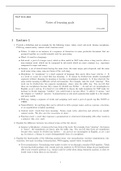Samenvatting
Natural Language Processing Technology (L_AAMAALG005): Summary of learning goals
- Instelling
- Vrije Universiteit Amsterdam (VU)
This document includes answers to all learning goals for each lecture of Natural Language Processing Technology, INCLUDING reading comprehension answers!
[Meer zien]




